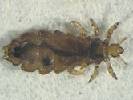
WEDNESDAY, Oct. 31 (HealthDay News) — A new topical lotion may offer parents a faster, more effective way to get rid of head lice.
Researchers report that just one treatment of topical ivermectin, an insecticide, kept almost three-quarters of treated children lice-free two weeks after treatment. That was without the dreaded fine-toothed combing to remove the lice eggs (nits) that leaves so many children in tears.
“This is a new agent that requires a one-time application that shows no resistance yet,” said study author Dr. David Pariser, a professor of dermatology at Eastern Virginia Medical School in Norfolk, Va. “Current treatments are only about 50 percent effective. This is a one-time treatment with higher effectiveness than anything else that’s out there.”
Results of the study, which was sponsored by the drug’s manufacturer, appear in the Nov. 1 issue of the New England Journal of Medicine.
The mere mention of head lice is enough to terrify most parents. Lice infestations affect all socioeconomic levels, and the critters have become increasingly resistant to treatment. Worldwide, hundreds of millions of people are infected with lice each year, according to an accompanying editorial in the same issue of the journal.
Lice commonly infest children between the ages of 3 and 11, though they can be found on people of all ages. In the United States, the estimated direct and indirect cost of head lice annually is $1 billion, according to the editorial.
The current study reports on two multi-site randomized, double-blind clinical trials. Sites included in the studies were: Arizona, Arkansas, California, Florida, Mississippi, New Mexico, North Carolina, Ohio, Tennessee, Texas and Virginia.
A total of 765 people older than 6 months who had an active head lice infestation were included in the studies. Half were randomly selected to receive treatment with 0.5 percent ivermectin lotion, while the other half received a placebo lotion. The study treatment did not include combing to remove nits.
The ivermectin was applied to dry hair and left on for 10 minutes before it was rinsed off.
On the second day, 95 percent of the treated group was louse-free compared to 31 percent of the control group. On the eighth day, 85 percent of the treated group was louse-free compared to 21 percent of the untreated group. By the fifteenth day, 74 percent of the treated group remained louse-free, while just 18 percent of the placebo group remained critter-free.
Pariser said it’s possible that the topical ivermectin treatment could be even more effective if a second application was given, though this hasn’t been studied and there currently aren’t any plans to do such a study. He said it might also be more effective if it was used in combination with nit combing.
Side effects from the treatment were mild and included itching and skin redness, which could also have been caused by the lice infestation.
Topical ivermectin, made by Topaz Pharmaceuticals, which is now part of Sanofi Pasteur, has U.S. Food and Drug Administration approval and is currently available by prescription.
But, not everyone is convinced that this should be a first-line treatment, because there is no long-term safety data available on the topical formulation.
Since there are no good studies comparing treatments, the editorial authors advise parents to follow the guidelines from the American Academy of Pediatrics, and first treat head lice with either 1 percent permethrin or pyrethrin insecticide. If resistance is present or lice are still alive a day after treatment, they recommend switching to malathion. They also suggest combing through wet hair to remove nits.
“Ivermectin should be the last choice, whether topical [for still infested persons] or oral [especially for mass treatment]. Management should also include more frequent checking for head-louse infestation in families and schools,” they wrote.
More information
The U.S. National Institutes of Health has more on head lice.

